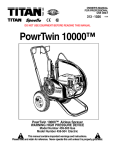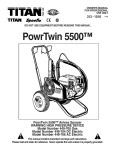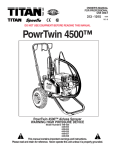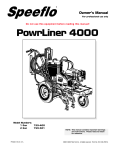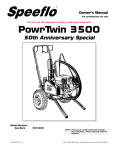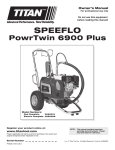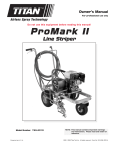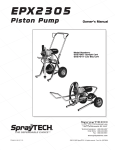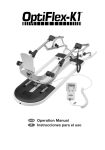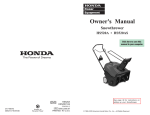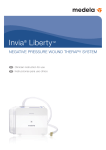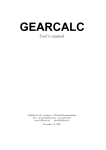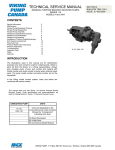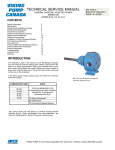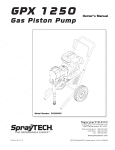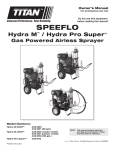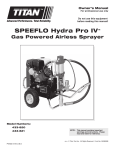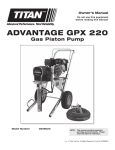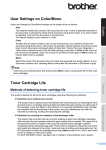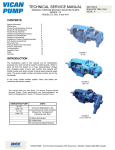Download PowrTwin 3500™
Transcript
OWNER'S MANUAL FOR PROFESSIONAL USE ONLY 313 - 1014 Rev. B 0799 DO NOT USE EQUIPMENT BEFORE READING THIS MANUAL PowrTwin 3500™ PowrTwin 3500™ Airless Sprayer WARNING HIGH PRESSURE DEVICE Model Numbers 335-500 335-501 335-502 335-503 This manual contains important warnings and instructions. Please read and retain for reference. Never operate this unit unless it is properly grounded. Parts List, Drawings and Service Instructions Model Descriptions / Major Components . . . . . . . . . . . . . . . . . . . . . . . . . .16 Power Convertokits . . . . . . . . . . . . . . . . . . . . . . . . . . . . . . . . . . . .17, 18, 19 Cart Assembly . . . . . . . . . . . . . . . . . . . . . . . . . . . . . . . . . . . . . . . . . . . . .20 Hydraulic System . . . . . . . . . . . . . . . . . . . . . . . . . . . . . . . . . . . . . . . . . . .21 Hydraulic Motor . . . . . . . . . . . . . . . . . . . . . . . . . . . . . . . . . . . . . . . . . .22, 23 Fluid Pump . . . . . . . . . . . . . . . . . . . . . . . . . . . . . . . . . . . . . . . . . .24, 25, 26 Bleed Line/Syphon Hose . . . . . . . . . . . . . . . . . . . . . . . . . . . . . . . . . . . . . .27 Outlet Manifold Filter Assembly . . . . . . . . . . . . . . . . . . . . . . . . . . . . . . . . .28 Table of Contents Specifications . . . . . . . . . . . . . . . . . . . . . . . . . . . . . . . . . . . . . . . . . . . . . . .3 Safety Warnings . . . . . . . . . . . . . . . . . . . . . . . . . . . . . . . . . . . . . . . . . . . . .5 Operating Controls . . . . . . . . . . . . . . . . . . . . . . . . . . . . . . . . . . . . . . . . . . .8 Setup . . . . . . . . . . . . . . . . . . . . . . . . . . . . . . . . . . . . . . . . . . . . . . . . . . . . .9 Fueling . . . . . . . . . . . . . . . . . . . . . . . . . . . . . . . . . . . . . . . . . . . . . . . . . . . .9 Startup . . . . . . . . . . . . . . . . . . . . . . . . . . . . . . . . . . . . . . . . . . . . . . . . . . .10 Color Change / Clean Out / Flushing . . . . . . . . . . . . . . . . . . . . . . . . . . . . .10 Maintenance . . . . . . . . . . . . . . . . . . . . . . . . . . . . . . . . . . . . . . . . . . . .11, 12 Key Accessories & Service Kits . . . . . . . . . . . . . . . . . . . . . . . . .29, 30, 31 Warranty . . . . . . . . . . . . . . . . . . . . . . . . . . . . . . . . . . . . . . . . . . . . . . . . .32 Troubleshooting Guide Airless Spraying . . . . . . . . . . . . . . . . . . . . . . . . . . . . . . . . . . . . . . . . . . . .13 Spray Patterns . . . . . . . . . . . . . . . . . . . . . . . . . . . . . . . . . . . . . . . . . . . . .14 Hydraulic Motors . . . . . . . . . . . . . . . . . . . . . . . . . . . . . . . . . . . . . . . . . . . .15 Fluid Pumps . . . . . . . . . . . . . . . . . . . . . . . . . . . . . . . . . . . . . . . . . . . . . . .15 PowrTwin 3500™ Congratulations on having selected the finest airless sprayer available in the world. Titan/Speeflo piston pumps are tireless workhorses - so tough they are virtually indestructible, even under the most severe service. Titan/Speeflo designs and builds equipment with superior quality and reliability. Equipment that will last for years with minimal maintenance and downtime. This equipment will make you money year after year. We thank you for your purchase and welcome you to our large and growing family of Titan/Speeflo users. The unique ability of this PowrTwin 3500™ to operate with either gas or electric power provides you with the flexibility to work indoors or outside where no electricity is available. Hydraulic drive makes possible the longest stroke and slowest cycling pumps in the industry which translates into low maintenance and longer life. Electric units operate quietly with no motor starting and stopping. The PowrTwin 3500™ is equipped with Titan/Speeflo's exclusive and patented Severe Service 300™ fluid pump. This technology will give you significantly longer rod, cylinder, and packing life than any other sprayer built in the world. This double ball piston pump employs a dependable and durable time-tested design. All pumps use an exclusive thick hard chrome plating on rod and cylinder parts. This patented plating process is harder than nitralloy, stainless steel, or hard chrome used by any other paint pump manufacturer and much more abrasion resistant. Highly polished parts reduce friction, extend packing life, and avoid damage from corrosion and abrasion. More than 75,000 of these pumps are in operation around the world. PowrTwin 3500™ offers other cost saving features: • Variable Pressure Control • Choice of Power - Gas or Electric • Tungsten Carbide Valve Seats • Self-Adjusting Packings • Exclusive Hand-Tight Swivel Foot Valve • Large Capacity Inline Paint Filter • "Floating Ball" Pressure Bleed Valve • 5 Gallon Syphon Hose and Bleed Line Assemblies are standard. You have made an excellent choice. We know you will be pleased with your new PowrTwin 3500™. Thanks again for selecting Titan/Speeflo. We appreciate your business. U.S. Patents: 3,936,002; 4,220,286; 4,457,472; 4,508,268; 4,494,697; 4,500,119; 4,626,004; 4,611,758; 4,744,571; 4,728,213; 4,768,932; 4,755,638; 4,768,929; 4,840,543; 4,908,538; 5,074,467; 5,425,506 WARNING: The Engine Exhaust from this product contains chemicals known to the State of California to cause cancer, birth defects, or other reproductive harm. 2 CAUTION: DO NOT use this equipment to spray water or acid. CAUTION: Do not lift by cart handle when loading or unloading. WARNING LABELS Your sprayer has the English language Warning Label shown on Page 5 in the location indicated below. If you require this label in French, German, or Spanish, or require additional English labels, order directly from Titan free of charge. Call toll free 1-800-526-5362. PART NO. LANGUAGE 313-771 313-784 English 313-1306 313-1307 Spanish 313-785 313-786 French 313-787 313-788 German GASOLINE ENGINE SAFETY 1. Honda engines are designed to give safe and dependable service if operated according to instructions. Read and understand the Honda Owner's Manual before operating the engine. Failure to do so could result in personal injury or equipment damage. 2. To prevent fire hazards and to provide adequate ventilation, keep the engine at least 1 meter (3 feet) away from buildings and other equipment during operation. Do not place flammable objects close to the engine. 3. Children and pets must be kept away from the area of operation due to a possibility of burns from hot engine components or injury from any equipment the engine may be used to operate. 4. Know how to stop the engine quickly, and understand the operation of all controls. Never permit anyone to operate the engine without proper instructions. 5. Gasoline is extremely flammable and is explosive under certain conditions. 6. Refuel in a well-ventilated area with the engine stopped. Do not smoke or allow flames or sparks in the refueling area or where gasoline is stored. 7. Do not overfill the fuel tank. After refueling, make sure the tank cap is closed properly and securely. 8. Be careful not to spill fuel when refueling. Fuel vapor or spilled fuel may ignite. If any fuel is spilled, make sure the area is dry before starting the engine. 9. Never run the engine in an enclosed or confined area. Exhaust contains poisonous carbon monoxide gas; exposure may cause loss of consciousness and may lead to death. 10. The muffler becomes very hot during operation and remains hot for a while after stopping the engine. Be careful not to touch the muffler while it is hot. To avoid severe burns or fire hazards, let the engine cool before transporting it or storing it indoors. 11. Never ship/transport unit with gasoline in tank. 4 DO NOT USE EQUIPMENT BEFORE READING THIS SECTION WARNING HIGH PRESSURE SPRAY CAN CAUSE SERIOUS INJURY Maximum Working Pressure 3000 psi, 207 bar An airless spray gun requires that fluid be introduced to it at very high pressure. Fluids under high pressure, from spray or leaks, can penetrate the skin and inject substantial quantities of toxic fluid into the body. If not promptly and properly treated, the injury can cause tissue death or gangrene and may result in serious, permanent disability or amputation of the wounded part. Therefore, extreme caution must be exercised when using any airless spray equipment. IF YOU ARE INJECTED, SEE A PHYSICIAN IMMEDIATELY. DO NOT TREAT AS A SIMPLE CUT! NOTE TO PHYSICIAN: Injection into the skin is a serious, traumatic injury. It is important to treat the injury surgically as soon as possible. Do not delay treatment to research toxicity. Toxicity is a concern with some exotic coatings injected directly into the bloodstream. Consultation with a plastic surgeon or a reconstructive hand surgeon may be advised. 1) Handle the spray gun carefully. Keep clear of the nozzle. NEVER point the gun at yourself or anyone else. NEVER permit any part of your body to come in contact with the fluid stream of either the gun or any hose leak. ALWAYS keep the gun trigger safety lever in a locked position when not spraying. ALWAYS use a tip safety guard. 2) NEVER attempt to force the flow of fluid backward through the gun with your finger, hand or hand-held object against the gun nozzle. THIS IS NOT AN AIR SPRAY GUN. 3) NEVER attempt to remove tip, disassemble or repair equipment without first doing IMPORTANT -- PRESSURE RELIEF PROCEDURE ALWAYS reduce pressure when you are cleaning a clogged tip, changing a tip, servicing any part of the system, or shutting down. Follow the steps below: 1. Engage the gun trigger lock. 2. Shut off the power source. 3. Close the orange handle shut-off ball valve on the hydraulic pressure hose. 4. Open the Pressure Bleed Valve by turning it counterclockwise at least three full turns. 5. Disengage the gun trigger lock and hold trigger open until flow of material stops. 6. Be certain to hold a metal part of the gun firmly to the side of a grounded metal container. 7. Reset trigger safety to locked position. the following: 4) Before flushing system, always remove spray tip and adjust fluid pressure to lowest possible setting. 5) Tighten all fluid connections before each use. NEVER exceed 3000 psi (207 bar) with this unit. Make sure that all accessory hoses, connections, swivels and so forth can withstand the high pressures which develop. NEVER exceed the pressure rating of any component in the system. 6) WARNING: The paint hose can develop leaks from wear, kinking, abuse, etc. A leak is capable of injecting fluid into the skin, therefore the paint hose should be inspected before each use. NEVER attempt to plug a hose with any part of your body, adhesive tape or any other makeshift device. Do not attempt to repair a spray hose. Instead, replace it with a new grounded hose. Use only with hoses that have spring guards. NEVER use less than 50' (15,2m) of hose with this unit. 7) Be sure that the airless equipment being used and the object being sprayed are properly grounded to prevent static discharge or sparks which could cause fire or explosion. WARNING: ALWAYS hold the gun against metal container when flushing system with tip removed, to prevent static discharge. CAUTION: To reduce the risk of electrical shock, do not expose to rain. Store indoors. GROUNDING INSTRUCTIONS: This product should be grounded. In the event of an electrical short circuit, grounding reduces the risk of electric shock by providing an escape wire for the electric current. This product is equipped with a cord having a grounding wire with an appropriate grounding plug.The plug must be plugged into an outlet that is properly installed and grounded in accordance with all local codes and ordinances. DANGER - Improper installation of the grounding plug can result in a risk of electric shock. If repair or replacement of the cord or 5 plug is necessary, do not connect the grounding wire to either flat blade terminal. The wire with insulation having an outer surface that is green (with or without yellow stripes) is the grounding wire. Check with a qualified electrician or serviceman if the grounding instructions are not completely understood, or if in doubt as to whether the product is properly grounded. Do not modify the plug provided; if it will not fit the outlet, have the proper outlet installed by a qualified electrician. • This product is for use on a nominal 120volt circuit and has a grounding plug that looks like the plug illustrated below. • Make sure that the product is connected to an outlet having the same configuration as the plug. No adapter should be used with this product. EXTENSION CORDS: Use only a 3-wire extension cord that has a 3-slot receptacle that will accept the plug on the pump. Make sure your extension cord is in good condition. When using an extension cord, be sure to use one heavy enough to carry the current this pump will draw. For lengths less than Use extension gauge 25 ft. (7,5 meters) 16 AWG 50 ft. (15 meters) 14 AWG 100 ft. (30 meters) 12 AWG 150 ft. (45 meters) 10 AWG An undersized cord will cause a drop in line voltage resulting in loss of power and overheating. If in doubt, use the next heavier gauge. The smaller the gauge number, the heavier the cord. 8) ALWAYS keep the working area around the pump well ventilated. Additionally, the pump itself should be a minimum of 25' (7.5m) from the spray area. If these instructions are not followed, there is the possibility of fire or explosion with certain materials. ALWAYS follow the coating or solvent manufacturer's safety precautions and warnings. Never spray flammable material near open flames, pilot lights or any source of ignition. 9) ALWAYS wear spray masks and protective eyewear while spraying. Additional personal protective equipment may be required depending on the type of material being sprayed and conditions of ventilation. Always contact supplier of material being sprayed for recommendation. 10) Keep all extension poles clear of electrical wires. 11) NEVER alter or modify any part of this equipment; doing so could cause it to malfunction. 12) NEVER leave equipment unattended. Keep away from children or anyone not familiar with the operation of airless equipment. NO USE EL EQUIPO ANTES DE LEER ESTA SECCION ADVERTENCIA LA ROCIADURA A PRESION ALTA PUEDE CAUSAR LESION GRAVE. Presión de Trabajo Máxima 3000 libras por pulgada cuadrada (psi), 207 bar Una pistola rociadora sin aire requiere que se le introduzca líquido a presión muy alta. Los líquidos bajo presión alta, de la rociadura o de las fugas, pueden penetrar en la piel e inyectar en el cuerpo cantidades considerables de líquido tóxico. Si no se atiende rápida y apropiadamente, la lesión puede causar muerte del tejido o gangrena, y puede resultar en incapacidad seria y permanente o en la amputación de la parte lesionada. Por lo tanto, hay que emplear precauciones estrictas al usar cualquier equipo de rociadura sin aire. SI USTED HA ESTADO EXPUESTO A LA PENETRACION DE TOXICOS POR INYECCION, CONSULTE INMEDIATAMENTE AL MEDICO. ¡NO TRATE LA HERIDA COMO SI FUERA UNA MERA CORTADURA! NOTA PARA EL MEDICO: La penetración de tóxicos en la piel es una herida seria y traumática. Es importante tratar la herida quirúrgicamente lo más pronto posible. No demore el tratamiento para investigar la toxicidad. La toxicidad es asunto serio cuando se trata de la penetración de ciertos revestimientos tóxicos en la corriente sanguínea. Puede que sea necesaria la consulta con un cirujano plástico o un cirujano especialista en la reconstrucción de la mano. 1) Maneje la pistola de rociadura con cuidado. Manténgase alejado de la boquilla. JAMAS apunte la pistola hacia usted u otra persona. NUNCA permita que parte alguna de su cuerpo se ponga en contacto con el chorro de líquido de la pistola o de alguna fuga de la manguera. SIEMPRE mantenga trabado el seguro de la pistola mientras no esté rociando. SIEMPRE utilice el protector de seguridad de la boquilla. 2) JAMAS intente forzar el flujo del líquido por la pistola hacia atrás con el dedo, la mano o un objeto sostenido con la mano contra la boquilla de la pistola, ya que NO SE TRATA DE UNA PISTOLA DE ROCIADURA DE AIRE. 3) JAMAS intente quitar la boquilla ni desarmar o reparar el equipo sin haber cumplido antes con los pasos siguientes: IMPORTANT -- PRESSURE RELIEF PROCEDURE ALWAYS reduce pressure when you are cleaning a clogged tip, changing a tip, servicing any part of the system, or shutting down. Follow the steps below: 1. Engage the gun trigger lock. 2. Shut off the power source. 3. Close the orange handle shut-off ball valve on the hydraulic pressure hose. 4. Open the Pressure Bleed Valve by turning it counterclockwise at least three full turns. 5. Disengage the gun trigger lock and hold trigger open until flow of material stops. 6. Be certain to hold a metal part of the gun firmly to the side of a grounded metal container. 7. Reset trigger safety to locked position. 4) Antes de lavar el sistema, siempre quite la boquilla de rociadura y ajuste la presión del líquido al valor más bajo posible. 5) Ajuste todas las conexiones antes de cada uso. JAMAS supere 3000 libras (207 bar) por pulgada cuadrada con esta unidad. Asegúrese de que todas las mangueras, conexiones, articulaciones giratorias y demás elementos accesorios estén en condiciones de tolerar las altas presiones que se presentan. JAMAS exceda la clasificación de presión de cualquier componente del sistema. 6) ADVERTENCIA: La manguera de pintura puede presentar fugas como resultado del desgaste, retorcimiento, abuso, etc. Las fugas pueden inyectar líquido a través de la piel, por lo que la manguera de pintura debe ser inspeccionada antes de cada uso. JAMAS intente obturar la manguera con una parte de su cuerpo o con tela adhesiva o cualquier otro elemento improvisado. No intente reparar una manguera de rociadura; en cambio reemplácela con una manguera nueva conectada a tierra. Utilice solamente mangueras con protector de resorte. JAMAS use una manguera de menos de 15,2 m con esta unidad. Almacenar bajo techo. INSTRUCCIONES PARA LA PUESTA A TIERRA: Este producto debe conectarse a tierra. En caso de corto circuito, la conexión a tierra proporciona una vía de escape para la corriente eléctrica y reduce el riesgo de choques eléctricos. El producto está dotado de un cable provisto de un alambre y de un enchufe de puesta a tierra. El enchufe debe enchufarse en un tomacorriente debidamente instal- ado y dotado de conexión a tierra, de acuerdo con las estipulaciones de los códigos y ordenanzas locales. PELIGRO — La instalación incorrecta del enchufe de puesta a tierra podría crear el riesgo de choque eléctrico. Si es necesario reparar o reemplazar el cordón o el enchufe, no conecte el alambre de puesta a tierra a ninguna de las dos terminales de cuchilla plana. El alambre con aislamiento exterior verde, con o sin rayas amarillas, es el alambre de puesta a tierra. Consulte a un electricista o técnico competente si no comprende bien las instrucciones para la conexión a tierra o si tiene dudas de que el producto está conectado a tierra correctamente. No modifique el enchufe que viene con el producto; si no encaja en el tomacorriente, pida a un electricista competente que instale el tomacorriente apropiado. • Este producto ha sido diseñado para usarse en 6 un circuito de tensión nominal de 120 voltios y está dotado de un enchufe de puesta a tierra semejante a la ilustrada más adelante. • Asegúrese de que el producto esté enchufado en un tomacorriente que tenga la misma configuración del enchufe. No debe usarse ningún adaptador. CORDON DE EXTENSION — Use sólo un cordón de extensión trifilar que tenga un enchufe de puesta a tierra con tres cuchillas, y un receptáculo con tres ranuras que acepte el enchufe que viene con el producto. Cerciórese de que el cordón de extensión esté en buen estado. Al usar un cordón de extensión, cerciórese de que sea suficientemente grueso para transportar la corriente que su producto usará. Para tramos de menos de: Use cordones de calibre: 7,6 m 16 AWG 15,2 m 14 AWG 30,4 m 12 AWG 45,7 m 10 AWG Un cordón demasiado corto provocará una caída de la tensión, ocasionando una pérdida de potencia y recalentamiento. Si tiene dudas, use un calibre más grueso. Cuanto más pequeño sea el número de calibre, más grueso será el cable. 7) Asegúrese de que el equipo sin aire que esté empleando y el objeto que se intenta rociar estén correctamente conectados a tierra para evitar descargas estáticas o chispas que podrían ocasionar incendio o explosión. ADVERTENCIA: Sostenga SIEMPRE la pistola contra el receptáculo de metal al limpiar el sistema con la boquilla desprendida, para evitar la descarga estática. ADVERTENCIA: Para reducir riesgo de descarga eléctrica, no exponer a la lluvia. 8) SIEMPRE mantenga el lugar de trabajo alrededor de la bomba bien ventilado. Además, la bomba en sí debe estar ubicada a no menos de 7,6 m de la operación de rociadura. Si no se observan estas instrucciones, existe el riesgo de incendio o explosión con ciertos materiales. SIEMPRE observe las precauciones y advertencias de los fabricantes sobre revestimientos y solventes. Nunca rocíe material inflamable cerca de llamas expuestas, llamas piloto o cualquier fuente de ignición. 9) SIEMPRE use máscaras apropiadas y anteojos de protección durante la operación de rociadura. Según el tipo de material que se está rociando y las condiciones de ventilación puede ser necesario usar equipo personal protector adicional. Siempre comuníquese con el proveedor del material para conseguir recomendaciones. 10) Mantenga todas las varas de extensión fuera del alcance de cables eléctricos. 11) JAMAS altere o modifique parte alguna de este equipo, ya que ello puede causar deficiencias de funcionamiento. 12) JAMAS deje al equipo solo. Manténgalo fuera del alcance de los niños o de cualquier persona no familiarizada con la operación de equipo sin aire. NE PAS UTILISER LE MATERIEL AVANT D’AVOIR LU CETTE SECTION ATTENTION! LES PULVERISATEURS A HAUTE PRESSION PEUVENT PROVOQUER DE SERIEUSES LESIONS Pression de travail maximale: 3000 psi — 207 bar Le liquide introduit dans un pistolet pulvérisateur sans air doit l’être à pression extrêmement élevée. Les liquides à haute pression, en provenance du pulvérisateur ou d’une fuite quelconque, sont capables de pénétrer la peau et d’injecter d’importantes quantités de liquide toxique dans l’organisme. Si elle n’est pas traitée promptement et avec toute l’attention voulue, la lésion causée de la sorte peut provoquer la nécrose des tissus ou la gangrène et donner lieu à de sérieux handicaps permanents, voire à l’amputation du membre atteint. Une prudence extrême s’impose donc lors de l’utilisation de matériel de pulvérisation sans air. EN CAS D’INJECTION, CONSULTEZ UN MEDECIN IMMEDIATEMENT. NE TRAITEZ PAS LA BLESSURE COMME S’IL S’AGISSAIT D’UNE SIMPLE COUPURE! REMARQUE A L’INTENTION DU MEDECIN : Une injection pénétrant la peau constitue une lésion traumatique grave qu’il est important de traiter chirurgicalement aussitôt que possible. Ne perdez pas de temps à rechercher la toxicité de l’injection. Il s’agit là d’un risque à envisager en cas d’injection directe dans le circuit sanguin de certains revêtements exotiques. La consultation d’un chirurgien plasticien ou d’un spécialiste de la chirurgie reconstructive de la main peut être conseillée. 1) Maniez le pistolet avec soin. Maintenez-vous à l’écart de la buse. N’en dirigez JAMAIS la buse vers aucune partie de votre corps ou vers aucune autre personne. Ne laissez JAMAIS aucune partie de votre corps entrer en contact avec le flux de liquide s’échappant du pistolet ou d’une fuite quelconque au niveau du flexible. Verrouillez TOUJOURS le levier de sûreté de la détente lorsque vous n’êtes pas occupé à pulvériser. Veillez à TOUJOURS utiliser un dispositif de sûreté à la buse du pistolet. 2) N’essayez JAMAIS de refouler le flux de liquide dans le pistolet au moyen de votre doigt, de votre main ou d’un objet maintenu contre la buse du pistolet. CET APPAREIL N’EST PAS UN PISTOLET PULVERISATEUR A AIR. N’utilisez aucune pièce de matériel sans air avec une pompe non équipée d’une IMPORTANT -- PRESSURE RELIEF PROCEDURE ALWAYS reduce pressure when you are cleaning a clogged tip, changing a tip, servicing any part of the system, or shutting down. Follow the steps below: 1. Engage the gun trigger lock. 2. Shut off the power source. 3. Close the orange handle shut-off ball valve on the hydraulic pressure hose. 4. Open the Pressure Bleed Valve by turning it counterclockwise at least three full turns. 5. Disengage the gun trigger lock and hold trigger open until flow of material stops. 6. Be certain to hold a metal part of the gun firmly to the side of a grounded metal container. 7. Reset trigger safety to locked position. soupape de surpression. 3) N’essayez JAMAIS d’enlever la buse, de démonter ou de réparer l’appareil avant d’avoir accompli la procédure suivante : 4) Avant de procéder au rinçage du système, enlevez toujours la buse de pulvérisation et réglez la pression au niveau le plus faible possible. 5) Serrez bien tous les raccords du système hydrodynamique avant chaque emploi. Ne dépassez JAMAIS, avec cet appareil, une pression de 3000 psi (207 bar). Assurez-vous que tous les flexibles accessoires, raccords, articulations, etc. sont bien capables de résister aux hautes pressions prévues. Ne dépassez JAMAIS la capacité de pression nominale d’aucun composant du système. DANGER : Afin de réduire tout risque d’électrocution, n’exposez pas à la pluie. 6) ATTENTION : Des fuites risquent de se produire le long du flexible de peinture sous l’effet de l’usure, des torsions, des rudes traitements, etc. auxquels il est éventuellement soumis. Les injections de liquide dans la peau sont possibles par la voie de telles fuites. Il est donc important d’inspecter le flexible avant chaque usage. N’essayez JAMAIS d’obturer une fuite à l’aide de votre doigt ou de tout autre membre de votre corps, de ruban adhésif ou de tout autre moyen de fortune. N’essayez pas non plus de réparer un flexible de pulvérisation ; remplacez-le plutôt par un nouveau flexible mis à la terre. Veillez à n’utiliser que les flexibles munis de dispositifs de sécurité à ressort. N’utilisez JAMAIS moins de 15,2 m de flexible avec cet appareil. 7) Assurez-vous que le matériel sans air utilisé et que l’objet à peindre sont adéquatement mis à la terre, de façon à éviter toute décharge d’électricité statique ou toute étincelle susceptible de provoquer un incendie ou une explosion. ATTENTION : Tenez TOUJOURS le pistolet contre un récipient en métal lors du rinçage du système, après en avoir ôté la buse. Ne vaporisez JAMAIS de substances inflammables à proximité de flammes nues, lampes témoin ni d’aucune source d’allumage. Rangez à l’intérieur. INSTRUCTIONS DE MISE A LA TERRE : Ce produit doit être mis à la terre. Dans l’hypothèse d’un court-circuit électrique, la mise à la terre réduit le risque de chocs électriques en assurant un fil de fuite pour le courant électrique. Ce produit est pourvu d’un cordon possédant un fil de terre avec fiche appro- priée de mise à la terre. La fiche doit être branchée sur une prise qui est posée et mise à la terre adéquatement conformément à tous les codes et 7 règlements locaux. DANGER - La pose inappropriée de la fiche de terre peut provoquer un risque de chocs électriques. Si le cordon ou la fiche doit être réparé ou remplacé, ne raccordez pas le fil de terre à l’une ou l’autre borne à lame plate. Le fil possédant une isolation dont la surface extérieure est verte (avec ou sans rayures jaunes) est le fil de terre. Consultez un électricien ou un technicien de service compétent si vous ne comprenez pas parfaitement les instructions de mise à la terre ou si vous ne pouvez affirmer avec certitude que le produit est dûment mis à la terre. Ne modifiez pas la fiche fournie ; si elle ne rentre pas dans la prise, faites poser la prise appropriée par un électricien compétent. • Ce produit est destiné à être utilisé sur un circuit à tension nominale de 120 volts et a une fiche de terre qui ressemble à la fiche illustrée ci-après. • S’assurer que le produit est branché sur une prise ayant la même configuration que la fiche. Aucun adaptateur ne doit être utilisé avec ce produit. CORDONS DE RALLONGE - Utilisez uniquement un cordon de rallonge à trois fils pourvu d’une fiche de mise à la terre à trois lames, et une prise à trois fentes qui acceptera la fiche de la pompe. Assurezvous que votre cordon de rallonge est en bon état. Lorsque vous utilisez un cordon de rallonge, veillez à en utiliser un suffisamment puissant pour transporter le courant que consommera cette pompe. Pour les longueurs de moins de Utilisez une rallonge de calibre 7,6 m 16 AWG 15,2 m 14 AWG 30,4 m 12 AWG 45,7 m 10 AWG Un cordon sous-calibré provoquera une chute de tension secteur ayant pour conséquences une perte de puissance et une surchauffe. En cas de doute, utilisez le calibre immédiatement plus puissant. Plus le numéro de calibre est bas, plus le cordon est puissant. 8) Le moteur électrique de cet appareil n’est pas protégé contre les explosions. Il est donc essentiel d’assurer une bonne ventilation de la zone de travail et des alentours de la pompe. Il est également important de maintenir la pompe à une distance minimale de 7,6 m de la zone de pulvérisation. Certains matériaux présentent, à défaut de suivre ces consignes, un risque d’incendie ou d’explosion. Suivez TOUJOURS les précautions et avertissements du fabricant de chaque solvant ou revêtement utilisé. 9) Portez TOUJOURS un masque et des lunettes de protection lors de vos travaux de pulvérisation. D’autres articles de protection personnelle peuvent être nécessaires suivant le type de produit pulvérisé et les conditions d’aération. Demandez toujours ses recommandations à votre fournisseur. 10) Maintenez toutes les tiges de rallonge à distance des fils électriques. 11) N´altérez ou ne modifiez JAMAIS une partie quelconque de cet appareil, ce qui pourrait causer des défaillances. 12) Ne laissez JAMAIS le matériel sans surveillance. Gardez-le hors de portée des enfants et de toute personne inexpérimentée quant à l’usage de matériel sans air. of inlet screen and gun strainer. SET UP WARNING: Proper grounding is important. This applies to both gas and electric powered models. The passage of some materials through the nylon fluid hose will build up a static electric charge, which if discharged, could ignite solvent vapors present and create an explosion. WARNING: READ, UNDERSTAND AND FOLLOW ALL WARNINGS ON PAGES 4 - 7 BEFORE STARTING OR OPERATING THIS SPRAYER Required tools: Crescent Wrench 1. Connecting the Hoses: The syphon hose and the bleed line hose have factory installed Teflon tape on the male end of the hoses. Tighten the syphon hose and bleed line wrench tight. See Figure 1. FUELING WARNING: Gasoline is extremely flammable and is explosive under certain conditions. 1. ALWAYS turn the engine off before refueling. 2. Refuel in a well-ventilated area. 3. Do not smoke or allow flames or sparks in the refueling area or where gasoline is stored. 4. Do not overfill the fuel tank. After refueling, make sure the tank cap is closed properly and securely. 5. Be careful not to spill fuel when refueling. Spilled fuel or fuel vapor may ignite. If any fuel is spilled, make sure the area is dry before starting the engine. 6. Avoid repeated or prolonged contact with skin or breathing of vapor. KEEP OUT OF REACH OF CHILDREN. 2. One Gun Operation - Attach the gun and hose. Always use a spray hose at least 50 feet long. Do not use Teflon or thread sealant on this assembly. Do not install the spray tip at this time. 3. Two Gun Operation - Remove the plug from the second gun outlet. Connect a hose and a gun to the outlet. Specifications: Use automotive gasoline that has a pump octane number of 86 or higher, or that has a research octane number of 91 or higher. Unleaded fuel produces fewer engine and spark plug deposits and extends the life of exhaust system components. Never use stale or contaminated gasoline or an oil/gasoline mixture. Avoid getting dirt, dust or water in the fuel tank. Use of a lower octane gasoline can cause persistent "pinging" or heavy "spark knock" (a metallic rapping noise) which, if severe, can lead to engine damage. NOTE: If "spark knock" or "pinging" occurs at a steady engine speed under normal load, change brands of gasoline. If spark knock or pinging persists, consult your authorized Honda dealer. Failure to do so is considered misuse, and damage caused by misuse is not covered by Honda's Limited Warranty. Occasionally you may experience light spark knock while operating under heavy loads. This is no cause for concern, it simply means your engine is operating efficiently. FIGURE 1 4. Fill the Wet-Cup 1/2 full with Titan/Speeflo's Piston Lube, Part No. 700-925, supplied by the factory. This extends packing life. 5. Electric Models - Use a 20 amp service outlet. Always locate the AC electric model within 10 to 15 feet of the service outlet. Use a short electric cable and a long paint hose. Any extension cord will create some voltage drop. For both AC and DC models, if an extension cord is necessary, use only grounded 3 wire # 12 wire. If the unit is being operated in an area that is overloaded by other appliances or low voltage conditions, it is important to start the unit "unloaded." Tip the electric motor forward so that the belt is loosened and the motor starts without full load. This reduces the amperage draw on starting and may avoid kicking out the circuit breaker. 6. Be sure the PowrTwin system is grounded. All Titan/Speeflo units are equipped with a grounding lug. A grounding cable (not supplied) should be used to connect the unit to a true earth ground. Check your local electrical regulations for detailed grounding instructions. See Accessories, Page 31, for ordering information. 7. Strain all paints with Titan/Speeflo # 160-524 5 gallon Nylon Strainer or Titan/Speeflo # 160-124 1 gallon Nylon Strainer to assure trouble free operation and freedom from frequent cleaning 9 Gasolines containing alcohol: If you decide to use a gasoline containing alcohol (gasohol), be sure its octane rating is at least as high as that recommended by Honda. There are two types of "gasohol": one containing ethanol, and the other containing methanol. Do not use gasohol that contains more than 10% ethanol. Do not use gasoline containing methanol (methyl or wood alcohol) that does not also contain cosolvents and corrosion inhibitors for methanol. Never use gasoline containing more than 5% methanol, even if it has cosolvents and corrosion inhibitors. NOTE: Fuel system damage or engine performance problems resulting from the use of fuels that contain alcohol is not covered under the warranty. Honda cannot endorse the use of fuels containing methanol since evidence of their suitability is as yet incomplete. Before buying fuel from an unfamiliar station, try to find out if the fuel contains alcohol, if it does, confirm the type and percentage of alcohol used. If you notice any undesirable operating systems while using a gasoline that contains alcohol, or one that you think contains alcohol, switch to a gasoline that you know does not contain alcohol. If you are spraying a water based latex, flush with warm, soapy water followed by a clean water rinse. If you are using any other coating, flush with warm, soapy water followed by a solvent. Check with the material manufacturer for a compatible solvent. Place syphon tube assembly into proper solvent or water. B. Place waste container below bleed line. C. Start engine or electric motor. Turn Pressure Control Adjustment Knob clockwise (increasing pressure) until pump cycles evenly and solvent flows freely from bleed line. D. Close Pressure Bleed Valve by turning it clockwise. This allows the system to pressurize. Hold gun trigger open, without spray tip attached, until the fluid flows smoothly. See Figure 4. 7. Repeat above starting procedure with paint material. Lock gun trigger and attach spray tip. See the Technical Data Sheet or Operator's Manual on the gun provided for installation and selection of the proper tip size. 8. Test spray pattern. Operate the pump at the lowest hydraulic pressure which provides good atomization. See the Troubleshooting Guide if you are not getting the proper pattern. 9. Operating pressure is adjustable from 400 to 3000 psi (207 bar) by turning the Pressure Adjustment Knob clockwise. Do not turn the knob clockwise more than necessary to provide satisfactory atomization. Excess pressure wears out spray tips. 10. When restarting the unit, reduce the pressure at Pressure Control Adjustment Knob and Pressure Bleed Valve. STARTUP 1. Areas must be well ventilated to prevent hazardous operation with volatile solvents or exhaust fumes. WARNING: If lacquer or other flammable materials are to be sprayed, ALWAYS locate the unit outside the immediate spraying area. Failure to do so may cause an explosion. COLOR CHANGE / CLEAN OUT / FLUSHING 2. Locate the unit outside the immediate spraying area to avoid clogged air intake of the engine or electric motor with overspray. 3. Before starting the unit, check oil levels. A. The hydraulic fluid level should read "Full" on the dipstick. CHECK IT REGULARLY. See the Hydraulic System Maintenance Instructions on Page 11 for changing or adding hydraulic fluid. Do not overfill. Use only Titan/Speeflo Coolflo™ Hydraulic Fluid, Part No. 430-361. B. The gasoline engine oil level is determined by the manufacturer. Check the manufacturer's service manual supplied. IMPORTANT -- PRESSURE RELIEF PROCEDURE ALWAYS reduce pressure when you are cleaning a clogged tip, changing a tip, servicing any part of the system, or shutting down. Follow the steps below: 1. Engage the gun trigger lock. 2. Shut off the power source. 3. Close the orange handle shut-off ball valve on the hydraulic pressure hose. 4. Open the Pressure Bleed Valve by turning it counterclockwise at least three full turns. 5. Disengage the gun trigger lock and hold trigger open until flow of material stops. 6. Be certain to hold a metal part of the gun firmly to the side of a grounded metal container. IMPORTANT NOTE: Use of Titan/Speeflo's Coolflo™ Hydraulic Fluid is mandatory in the PowrTwin 3500™ hydraulic system. Do not use any other hydraulic fluid. Use of any other hydraulic fluid may seriously damage hydraulic system and will void warranty. 4. Open the orange handle shut-off valve located on the hydraulic pressure hose. Handle should be in line with hose. Figure 3 shows the handle in the open position. 5. Turn the Pressure Adjustment Knob counterclockwise (as viewed from top) to lowest pressure setting. See Figure 3. 6. Open the Pressure Bleed Valve by turning it counterclockwise. This relieves pressure. See Figure 4. A. Your new sprayer was tested at the factory with mineral spirits. You must clean the system before spraying to avoid contamination of the sprayed material. CLEANING A CLOGGED TIP 1. Follow the Pressure Relief Procedure above. 2. If tip clogs, rotate tip handle 180° until arrow on handle is facing the opposite of spray direction and clicks in reverse position. 3. Trigger gun once so that the pressure can blow the clog out. NEVER use the tip in the reverse position for more than ONE trigger pull at a time. This procedure can be repeated until the tip is free of clogging. WARNING: THE FLOW FROM THE SPRAY TIP IS AT VERY HIGH PRESSURE. CONTACT WITH ANY BODY PART MAY BE DANGEROUS. DO NOT PLACE FINGER ON GUN OUTLET. DO NOT POINT THE GUN AT ANY PERSON. NEVER OPERATE THE SPRAY GUN WITHOUT THE PROPER TIP GUARD. Figure 3 10 MAINTENANCE HYDRAULIC SYSTEM IMPORTANT INFORMATION: Use of Titan/Speeflo's Coolflo™ Hydraulic Fluid is mandatory in the PowrTwin 3500™ hydraulic system. Do not use any other hydraulic fluid. Use of any other hydraulic fluid will seriously damage hydraulic system and void warranty. 1. Check the hydraulic fluid daily. It should read "Full" on the dipstick. If it is low, add only Titan/Speeflo Coolflo™ Hydraulic Fluid, Part # 430-361. Never add or change hydraulic fluid except in a clean dust free area. Contamination of the hydraulic fluid will shorten Hydraulic pump life and may void warranty. FIGURE 4 COLOR CHANGE / CLEAN OUT CAUTION: USE ONLY COMPATIBLE SOLVENTS WHEN CLEANING OUT OIL BASED ENAMELS, LACQUERS, COAL TAR, AND EPOXIES. CHECK WITH THE FLUID MANUFACTURER FOR A RECOMMENDED SOLVENT. 1. Reduce pressure by turning the Pressure Adjustment Knob and the Pressure Bleed Valve on the bleed line counterclockwise. Follow the Pressure Relief Procedure above. The Pressure Bleed Valve should be turned counterclockwise at least three full turns. 2. Pull syphon tube out of material container. 3. Remove spray tip from gun. Hold gun trigger open until material flow stops. 4. Put syphon tube into wash solvent or water as applicable, and operate pump slowly at low pressure until solvent flows freely from Pressure Bleed valve line. 5. Close Pressure Bleed Valve and hold gun trigger open until solvent flows freely from gun. If solvent is not too dirty, recirculate it by flowing gun stream back into solvent container. Use additional clean solvent and repeat procedure if necessary. 6. Check gun strainer screen and pump outlet filter screen daily. Use 50 mesh screens with spray tip size .018 and larger. Use 100 or 200 mesh screens with spray tip sizes .015 and smaller. 7. Replace paint filter cap to maximum clockwise rotation. The filter cover should be hand removable after the first or second use with new Teflon O-Ring. IMPORTANT: O-Ring must have Teflon backup washer to seal properly. 8. If unit has been spraying a water soluble material, flush with water and then repeat procedure with mineral spirits or Varsol solvent. 9. Wash spray tip in solvent. Blow tip clean with air pressure directed through the tip in the reverse direction. FIGURE 5 2. Change the hydraulic fluid every six months. Drain old fluid from tank and fill with 5 quarts of Titan/Speeflo Coolflo™ Hydraulic Fluid. Start operation of the system at just enough pressure to operate the fluid pump. Run the system at this low pressure for at least 5 minutes. This removes air from the system. Check the fluid level after this procedure. 3. The Hydraulic System has an external replaceable Hydraulic Filter. Change the filter every six months. 4. The Hydraulic Pump should not be serviced in the field. If service on the Hydraulic Pump is required, it must be returned to Titan/Speeflo. GENERAL FLUID PUMP MAINTENANCE If the paint pump is going to be out of service for an extended period of time, it is recommended that following cleanup a kerosene and oil mixture be introduced as a preservative. Packings may tend to dry out from lack of use. This is particularly true of the upper packing set for which upper packing lubricant, Piston Lube, Titan/Speeflo Part # 700-925, is recommended in normal usage. A sample of Lubrisolv accompanies each new unit. Do not substitute water or paint solvent for Lubrisolv. Ordinary oil may contaminate the paint material and is not recommended. If the paint pump has been out of service for an extended period of time, it may be necessary to prime the suction by pouring some of the paint solvent into the inlet syphon tube to restart. It is extremely important that the threads on the inlet syphon hose coupling are properly sealed. Any air leakage will produce erratic operation of pump and may damage the system. The up and the down strokes should be approximately equal in time. That is, one should not be faster than the other. A fast up or down stroke may indicate air in the system or malfunctioning valve or seats. See the Troubleshooting Guide. 11 HYDRAULIC MOTOR & FLUID PUMP SERVICE See Page 22 for maintenance and service instructions on the reciprocating hydraulic motor and Page 26 for the fluid pump. BASIC ENGINE MAINTENANCE • For detailed engine maintenance and technical specifications refer to the separate Kawasaki engine manual. • All service to the engine should be performed by an authorized Kawasaki Power Equipment dealer. To locate a dealer in your area, look in the Yellow Pages of your telephone directory under Gasoline Engines, Garden & Lawn Equipment & Supplies, Lawnmowers, etc. • The Kawasaki engine is warranted exclusively by Kawasaki Heavy Industries, Ltd. • Use a premium quality motor oil certified to meet or exceed U.S. Automotive requirement SC, SD, SE, OR SF. SAE 10W30 is recommended for general all temperature use. Other viscosities may be required in other climates. • Use only a (NGK) BP5ES or BPR6E spark plug. Gap the plug to 0.027 to 0.031 In. (0.7 to 0.8 mm) Always use a spark plug wrench. DAILY: Check engine oil level. Fill as necessary. Check gasoline level. Fill as necessary. WARNING: FOLLOW FUELING PROCEDURE ON PAGE 10 FIRST 20 HOURS: Change engine oil. EVERY 100 HOURS: Change engine oil. WEEKLY: Remove the air filter cover and clean the element. In very dusty environments, check the filter daily. Replace the element as needed. Replacement elements can be purchased from your local Honda dealer. ENGINE OPERATION AND SERVICE 1. Clean and oil air filter pad on gasoline engine every 25 hours or once weekly. Do not permit the air intake screen around the fly wheel of the gas engine to load up with paint or trash. Clean it regularly. The service life and efficiency of the gas engine model depends upon keeping the gasoline engine running properly. Change the oil in the engine every 100 hours. Failure to observe this may result in engine overheating. Consult the engine manufacturer's service manual provided. 2. To conserve fuel, service life, and efficiency of the unit always operate the gasoline engine at the lowest RPM at which it runs smoothly without laboring and delivers the amount required for the particular painting operation. Higher RPM does not produce higher working pressure. The gasoline engine is connected to the hydraulic pump by a pulley combination designed to produce full paint delivery of 1.0 GPM at 3600 RPM. 3. The warranty on gasoline engines or electric motors is limited to the original manufacturer. IMPORTANT ELECTRIC MOTOR INFORMATION WARNING: If electric motor overloads and stops running, IMMEDIATELY turn the motor off and follow the Pressure Relief Procedure on Page 10. Wait until the motor cools (approximately 30 minutes). Then push in the bubble top, manual reset button, turn the motor on and pressurize the system. For CSA approved units only: The ON / OFF switch is also the RESET! 12 PowrTwin 3500™ Major Components GAS MODELS 1 5 6 2 3 4 ITEM NO. 1 2 3 4 4a 4b 5 6 GAS 3.5 HP Kawasaki 335-500 PART NO. DESCRIPTION 335-108 506-103 506-238 506-244 840-211 103-829 Motor/Pump Assembly Hydraulic System Cart Assembly Convertokit, 3.7 HP, Kawasaki, Gas Convertokit, 1.5 HP, DC Electric 50/60 Hz 115V Convertokit, 1.5 HP, DC Electric 50/60 Hz 220V Bleed Line Assembly w/Valve Syphon Hose Assembly, 3/4” x 4 1/2 16 1 1 1 1 1 1 DC DC ELECTRIC 1.5 HP GAS/ 1.5 HP 50/60 Hz 115 V ELECTRIC 50/60 Hz 220 V 335-501 335-502 335-503 1 1 1 1 1 1 1 1 1 1 1 1 1 1 1 1 1 1 1 PowrTwin 3500™ DC - Electric Convertokits DC - ELECTRIC CONVERTOKITS ITEM NO. PART NO. 1 1a 2 3 4 5 6 7 8 9 10 11 12 13 978-355 978-346 860-501 860-002 977-222 335-014 590-068 335-017 860-004 860-535 860-552 449-192 747-951 335-005 DESCRIPTION Motor, DC-Electric, 1.5 HP, 50 / 60 Hz, 115 V Motor, DC-Electric, 1.5 HP, 50 / 60 Hz, 220 V Nut Stop Washer, Lock Pulley Mount, Plate Grip, Handle Handle Washer, Flat Screw Screw Shield, Motor Shaft Decal Identification Kit (FRENCH) Belt (Not illustrated) *Not part of this assembly 18 506-238 115 V 506-244 220 V QTY QTY 1 4 4 1 1 1 1 8 2 2 1 4 4 1 1 1 1 8 2 2 * * PowrTwin 3500™ Electric Convertokits - Service Instructions WARNING: Before servicing the electric motor, follow the Pressure Relief Procedure on Page 10. Once you have completed this procedure, unplug the power supply cord. Failure to reduce pressure can result in serious injury. Observe all warnings. Note: Brushes should be replaced when they are worn to less than 1/2 inch. Check and replace both brushes at the same time. Brush Repair Kit, Part No. 978-050, consists of: 2 brushes, 2 springs, and 2 clips. 1. Remove both inspection covers on Motor. See Figure 1. FIGURE 3 4. Inspect the commutator for burning, excessive pitting or gouging. A black color on the commutator is normal. 5. Install the new brush so its lead slides in the long slot of the brush holder. Push the terminal under the terminal screw washer. Insure the motor lead is still connected at the screw. Tighten the FIGURE 1 2. Push in the Spring Clip to unhook it and then pull it out. See Figure 2. FIGURE 4 FIGURE 2 3. Loosen the terminal screw. Pull the brush lead away, but leave the motor lead in place. Remove the brush and spring. See Figure 3. screw. See Figure 4. 6. Place the spring on the brush as shown in Figure 4. Push in and hook the spring clip. Repeat this procedure for the other side. Reinstall the inspection covers. 19 PowrTwin 3500™ Cart Assembly CART ASSEMBLY ITEM NO. PART NO. DESCRIPTION 1 2 3 4 5 6 7 8 9 10 11 12 13 590-502 590-508 590-507 856-002 856-921 590-504 590-506 862-002 862-428 335-561 870-003 570-010 335-563 Handle Roll Pin Snap Button Washer Screw Sleeve Washer Washer, Lock Screw Wheel Washer Key, Cotter Spacer (Long) CART ASSEMBLY (Continued) QUANTITY 1 2 2 4 4 2 2 2 2 2 2 2 1 20 ITEM NO. PART NO. DESCRIPTION 14 15 16 17 18 19 20 21 22 23 24 25 26 27 335-562 449-051 335-558 862-460 854-020 335-018 335-557 335-552 862-428 862-001 448-233 862-002 862-411 449-052 Axle Motor/Pump Bracket Frame, Right Screw Screw Glide Frame, Left Spacer Screw, Cap Washer, Flat Belt Guard Washer, Lock Nut Spacer QUANTITY 1 1 1 1 2 2 1 1 1 2 1 2 2 1 PowrTwin 3500™ Hydraulic Motor ITEM NO. PART NO. DESCRIPTION 1 2 3 4 5 6 7 8 9 10 11 12 13 14 15 16 17 18 19 20 21 22 23 24 25 26 27 27a 235-018 141-007 325-005 569-016 441-908 441-152 235-030 441-217 858-811 818-002 235-112 431-032 431-053 431-054 192-000 235-022 235-008 235-027 235-026 235-021 235-948 235-001 235-007 235-028 235-923 235-029 197-031 431-019 Retainer, Trip O-Ring Spring, Trip Ball, SS Spool / Sleeve Set O-Ring Plug, Cylinder Head O-Ring Nut, Flex Lock Elbow, Street, 90O Cylinder Head O-Ring Retainer, Sleeve Ring, Retainer Elbow Screw, Piston Retainer Piston Seal, Piston O-Ring Valve Rod Assembly Piston Rod Ring, Lock Cylinder Seal, Rod Motor Pump Block Tube, Motor Tee O-Ring solvent and will severely damage seals and O-Rings of the hydraulic motor. QUANTITY 2 2 2 2 1 3 1 1 1 1 1 2 1 1 1 1 1 1 1 1 1 1 1 1 1 1 1 1 Gently push the Spool Sleeve Set (5) into Cylinder Head (11) using a nylon driver and a rubber mallet until sleeve has reached its full depth. Do not use any other type of tool that might leave particles or residue. 2. Install O-Rings (2) on Trip Retainers (1). Install the Trip Retainer Balls (4) followed by Springs (3) which, when installed, will hold the Spool (5) in proper place for assembly. 3. Install Sleeve Retainer (13) followed by Snap Ring (14) in Cylinder Head (11) which will hold valve sleeve in place. Install ORing (12) in O-Ring groove of cylinder head. 4. Replace Lower Seal (24) in Motor Block (25). Be sure the open portion of the seal is facing upward (V). This seal requires no special tool. 5. Place Piston Rod (21) in vise. Inspect Valve Rod Assembly (20) for any damage. Make sure the lock nut at the bottom of the Valve Rod Assembly (20) is secure. DO NOT remove. Then place into Piston Rod (21) as illustrated. Install O-Ring (19), lubricating it well and replacing Piston (17) onto Piston Rod (21). Put one drop of blue Loctite on the Piston Retainer Screw (16). Tighten piston retainer screw until piston is locked into place. Check Valve Rod Assembly (20) for normal spring action at this time. 6. Install Piston Seal (18) with lips facing downward. Carefully install The Piston Seal (18). Expand the ring and stretch it sufficiently for installation. 7. With Motor Pump Block (25) still in vise, install Lower Seal (24) by pushing it towards its groove with a properly sized blunt rod. Then complete installation with the fingers. No tool is necessary. Do not twist the seal. 8. Prelubricate the piston and valve rod assembly with Coolflo™ Hydraulic Fluid, Part No. 430-361. Install Piston Rod (21) into REASSEMBLY OF HYDRAULIC MOTOR 1. Replace O-Rings (6) onto Sleeve (5) after lubricating these parts with oil. CAUTION: Do not use Piston Lube pump packing lubricant. It is a 23 PowrTwin 3500™ Fluid Pump Service Instructions IMPORTANT: USE OF NON-SPEEFLO MANUFACTURED SERVICE PARTS MAY VOID WARRANTY. ASK FOR ORIGINAL PARTS MADE BY SPEEFLO FOR BEST SERVICES. The 143 Series Pump should receive a routine servicing after approximately 1,000 hours of use. Earlier servicing is required if there is excessive leakage from the top packing or if pump strokes become faster on one stroke or the other. The use of Titan/Speeflo Piston Lube, Part # 700-925, is recommended as an upper packing lubricant. DO NOT SUBSTITUTE OIL, WATER, OR SOLVENT for an upper packing lubricant. 7A DISASSEMBLY 1. Remove Syphon Assembly. Unthread Foot Valve (15) and Pump Cylinder (11) with strap wrench. 2. Slide the Retainer Ring (1) up with a small screwdriver, then push the Connecting Rod Pin (2) out. 3. Pull Displacement Rod (6) through lower cavity of Pump Block. 4. Remove Pump Block Teflon O-Ring (3), Packing Spring (5), and Packing Set (4). 5. Hold Displacement Rod (6) in vise by the flats at top of rod and remove Piston Seat (10) with wrench while holding displacement rod horizontal with wooden support if necessary. Remove Piston Ball (9), Packing Set (4), Lower Packing Spring (8) and Spring Retainer (7). 6. Remove Ball Stop Cage (13), Teflon O-Ring (3) and Foot Valve Ball (14). 7. Replace Connecting Rod Pin (2) and Retainer Ring (1) . 8. Remove O-Ring (12) from Pump Cylinder (11) 8A REASSEMBLY NOTE: USE TEFLON TAPE ON ALL THREADED PIPE CONNECTIONS. 1. Install Pump Cylinder O-Ring (3) and (12) into O-Ring groove of Pump Cylinder (11 ) and O-Ring (3) into Pump Block. 2. Place O-Ring (3) into Foot Valve (15). 3. Place Foot Valve Ball (14) in Foot Valve (15) and install Ball Stop Cage (13). 4. Connect Foot Valve (15) to Pump Cylinder (11). Place Packing Set (4) over Piston Seat (10). CAUTION: Peak of V packing must point down toward Foot Valve (15). Place Piston Ball (9) on Piston Seat (10). Follow with Lower Packing Spring (8) and Spring Retainer (7). Thread Displacement Rod (6) onto Piston Seat (10) tightly using red Loctite. 5. Insert Packing Set (4) into Pump Block. CAUTION: Peak of “V” packing must point up toward motor. Place Upper Packing Spring (5) (small end toward packing) into the lower cavity of Pump Block behind Upper Packing Set (4). 6. Insert Displacement Rod (6) through lower cavity of Pump Block. Rotate Displacement Rod until holes in Displacement Rod and hydraulic piston rod line up. 7. Push Cylinder (11) over Packings (4) and connect to Pump Block. CAUTION: O-Ring (3), and Packing Spring (5) must be in place before connecting Cylinder (11) to Pump Block. 8. Attach syphon assembly. ITEM NO. PART NO. DESCRIPTION QUANTITY * 235-923 Pump Block 1 *(See item No.m25 On Hydraulic Motor Assembly) 1 2 3 4 5 6 7 7A 8 8A 9 10 11 12 13 14 15 25 143-019 107-003 106-015 106-002 106-005 108-021 106-116 106-001 106-016 106-002 569-021 106-011 108-940 106-014 106-012 138-340 107-013 Retainer Ring Connector Rod Pin O-Ring, Teflon Packing Set, Leather/UHMWPE Packing Spring, SS Displacement Rod Sleeve Spring Retainer Packing Spring, SS Packing Set Leater/UHMWPE Ball, SS Piston, Seat Cylinder, Pump O-Ring Ball Cage, SS Ball, SS Foot Valve Assembly 1 1 2 1 1 1 1 1 1 1 1 1 1 1 1 1 1 840-211 BLEED LINE ASSEMBLY WITH VALVE Inlet Accessories Hoses and Valves ITEM NO. PART NO. DESCRIPTION QUANTITY 1 944-620 Bleed Valve 1 2 103-111 Bleed Line Assembly 1 3 539-078 Hose Assembly 1 4 103-117 Tube 1 ITEM NO. PART NO. DESCRIPTION 1 944-005 Knob 1 2 860-721 Nut, Lock 1 3 944-023 Valve Stem 1 5 944-004 O-Ring 1 6 944-026 Valve Stem Stop 1 7 569-170 Ball, T.C. 1 8 945-003 Gasket, Copper 1 9 944-904 Valve Seat 1 944-620 BLEED VALVE ASSEMBLY QUANTITY SERVICE INSTRUCTIONS The 944-620 Series Bleed Valve has a Tungsten Carbide Seat (9) and should not require frequent replacement. The Tungsten Carbide Ball (7), in normal service, will last a long time because it rotates and wears evenly. If there is leakage, replace the ball. CAUTION: Open the Adjustment Knob (1), to full counterclockwise position before unthreading Valve Seat (9), from Valve Body (4). If the Valve Stem (3) is rotated inwardly with me ball removed, the Teflon O-Ring (5), may require replacement. If mere has been leakage from the valve stem, the Teflon ORing should be replaced. IMPORTANT: The Valve Stem Stop (6), must be unthreaded from the Valve Stem (3), with a socket screwdriver, then the valve stem can be threaded out of the Valve Body. CAUTION: All non-moving threads must be assembled with Loctite Sealant, Speeflo Part # 426-051. 103-829 SYPHON HOSE ASSEMBLY 27 NO. NO. DESCRIPTION QTY 1 2 3 4 5 6 7 103-625 103-550 103-682 420-650 103-130 103-119 194-661 Rock Catcher Tube Hose Clamp Hose, 3/4” Spring Clip Adapter 1 1 2 4.5' 1 1 1 Outlet Accessories 930 Outlet Manifold Filter Assembly with Check Valve OUTLET MANIFOLD FILTER ASSEMBLY PART NO. 920-560 ITEM NO. PART NO. DESCRIPTION 1 2 3 3a 3b 4 5 6 7 8 9 10 11 12 920-917 920-103 920-004 920-001 920-005 920-006 920-070 920-927 227-027 814-002 940-553 227-006 191-440 227-033 Filter Cap Assembly Ball Filter Element, 50 M Filter Element, 5 Mesh Filter Element, 100 Mesh Gasket, Teflon (Thick) Gasket, Teflon (Thin) Filter Body Plug, Pipe Nipple, Hex Valve, Ball Nipple, Hex Nipple, Hex Plug, Pipe QTY 1 1 1 1 1 1 1 1 1 1 1 1 1 1 PART NO. 920-050 FILTER SERVICE KIT ITEM NO. PART NO. DESCRIPTION 2 4 5 920-103 920-006 920-070 Ball Gasket, Teflon Gasket, Teflon QUANTITY 1 1 1 SPECIFICATIONS Maximum Working Pressure 5000 psi (345 bar) Filter Area 18 In2 (116 cm2) Outlet Ports (1) 1/4" NPT(F) for bleed valve (1) 3/8" NPT(F) with 1/4 NPSM(M) hose connection (1) 3/8" NPT(F) plugged for additional gun hookup. Wetted Parts Carbon steel with electroless nickel and cadmium plating, stainless steel, tungsten carbide, Teflon 28 PowrTwin 3500™ Outlet Accessories (Optional) 2 Gun Manifold 2 GUN MANIFOLD PART NO. 970-110 ITEM NO. PART NO. DESCRIPTION QTY. 1 2 3 970-098 227-027 814-004 Manifold Plug, Pipe Nipple, Hex 1 1 1 30 TITAN LIMITED WARRANTY Titan Tool Inc. warrants all equipment manufactured by it and bearing its brand names to be free from defects in material and workmanship at the time of sale by an authorized Titan/Speeflo distributor. Titan Tool Inc. will for a period of twelve months (twenty-four months on selected air powered models) from the date of sale, repair or replace any part of the equipment proven defective. Repair or replacement under this warranty shall be purchaser's sole remedy for breach of this warranty. Products furnished by but not manufactured by Titan Tool Inc. (such as hose, motors, engines, hydraulic pumps, etc.) will carry only the warranty of the manufacturer, if any. (TITAN TOOL INC. DOES NOT WARRANTY AND DISCLAIMS ALL IMPLIED WARRANTIES OF MERCHANTABILITY AND FITNESS FOR A PARTICULAR PURPOSE FOR ACCESSORIES, MATERIALS, EQUIPMENT, COMPONENTS AND PRODUCTS NOT MADE BY TITAN TOOL INC.) Titan Tool Inc. will, at Titan Tool Inc.'s option, repair or replace any defective parts. The equipment will be returned including prepayment of transportation charges to the original purchaser. If no defects in material and workmanship are found, repairs will be made by Titan Tool Inc. at a reasonable charge. Charges may include the cost of parts, labor and freight. This warranty shall not apply if the product has been subject to misuse, negligence, accident or tampering or has not been operated or installed in accordance with Titan Tool Inc.'s recommendations. This warranty does not cover and Titan Tool Inc. shall not be liable for any damage, wear or malfunction caused by improper or inadequate maintenance, abrasion, corrosion or substitution of components, parts or hydraulic fluid not supplied by Titan Tool Inc. Titan Tool Inc. shall not be liable for the improper design, manufacture, installation, operation or maintenance of accessories, components or materials not supplied by Titan Tool Inc. Titan Tool Inc. shall not be liable for damage or wear caused by incompatibility with Titan Tool Inc. equipment of materials, equipment or accessories not supplied by Titan Tool Inc. TITAN TOOL INC. DISCLAIMS TO THE FULL EXTENT PERMITTED BY LAW ALL WARRANTIES, EXPRESSED OR IMPLIED, INCLUDING ANY WARRANTY OF MERCHANTABILITY OR WARRANTY OF FITNESS FOR A PARTICULAR PURPOSE AND ANY NON CONTRACTUAL LIABILITIES INCLUDING PRODUCT LIABILITY BASED ON NEGLIGENCE OR STRICT LIABILITIES. Every form of liability is expressly excluded and denied for direct, indirect, special or consequential damages or loss. This warranty shall be in lieu of any other warranty expressed or implied. The terms of this warranty constitute purchaser's sole and exclusive remedy. In no case shall Titan Tool Inc.'s liability exceed the amount of the purchase price. Any action for breach of warranty must be brought within two (2) years of the date of sale. No statement or recommendation made or assistance given by Titan Tool Inc. or its representatives to purchaser, lessee or user or its representatives shall constitute a warranty by Titan Tool Inc. or a waiver or modification of any of the provisions hereof to create any liability for Titan Tool Inc. No sample or model shall create an express warranty that the products shall conform to any sample or model exhibited by Titan Tool Inc. This warranty applies only to the original purchaser and only when the equipment is installed, operated and maintained in accordance with Titan Tool Inc.'s written recommendations or instructions. Purchaser must, with transportation prepaid, return the equipment claimed to be defective to Titan Tool Inc. or to an authorized Warranty Service Center for verification of the claimed defect. If the alleged defect is verified, © 1999 Titan Tool Inc. 313-1014 Printed inthe U.S.A. Rev. B 0799 National Sales & Service 1-800-526-5362 Fax 1-800-528-4826 Canadian Branch 1-800-565-8665 Fax 1-905-856-8496 International 1-201-405-7520 Fax 1-201-405-7449 556 Commerce Street Franklin Lakes, NJ 07417 200 Towers Road, Unit 7B Woodbridge, L4L 5Z8 556 Commerce Street Franklin Lakes, NJ 07417 USA TITAN and Speeflo are registered trademarks of Titan Tool Inc. 32




















